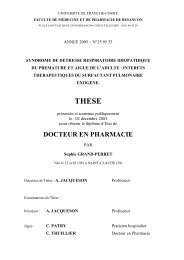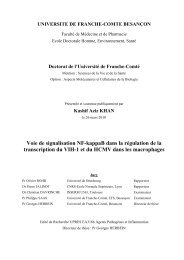THÈSE - Université de Franche-Comté
THÈSE - Université de Franche-Comté
THÈSE - Université de Franche-Comté
You also want an ePaper? Increase the reach of your titles
YUMPU automatically turns print PDFs into web optimized ePapers that Google loves.
Fig. 3 shows the results of a principle component analysis carried out on the matrix “13<br />
farming practice variables” x “46 parcels”. The two first components represented here<br />
accounted for 49.8 % of the total inertia. Nitrogen fertilisation and mowing variables (yield<br />
and number of annual cuttings) were the variables most correlated to Axis 1 (Fig. 3). The first<br />
principal component was thus interpreted as a gradient of intensification. This gradient<br />
opposed two types of parcel management: one where fertilisation and mowing are the main<br />
features and the other grazing.<br />
A. terrestris dynamics in relation to farming practices and to T. europaea relative abundance<br />
Among all variables of practices and T. europaea relative abundance, only those correlated to<br />
an A. terrestris population dynamic variables at a risk lower than 0.15 were kept (Table 3).<br />
Figs 4a and 4b are based on a redundancy analysis and show the overall canonical relationship<br />
according to the two first axes between the table “farming practices and T. europaea relative<br />
abundance” and the table “A. terrestris population dynamic variables”. This relationship was<br />
found to be globally significant (P < 0.01 after 999 permutations). The canonical axes<br />
explained 18.7 % and 5.5 % of the variance of the A. terrestris population dynamics,<br />
respectively (total 24.2 %). Fig. 4a represents the maximum values for each parcel in the<br />
canonical space: they were clearly larger in the parcels where the relative abundance of T.<br />
europaea was higher at the beginning of the study period (spring 2002) and where grazing<br />
took place in the fall. Furthermore, the parcels for which the increase of A. terrestris<br />
populations began later in a commune were those with the lowest number of cuttings and<br />
addition of organic nitrogen fertiliser (Fig. 4b). The four variables (tesp2, autgraz, organ and<br />
cutting) account for less than 30 per cent of total variance, suggesting another explanatory<br />
variable also affected the A. terrestris population kinetics.<br />
THE HIGH DENSITY PHASE OF AN A. TERRESTRIS POPULATION CYCLE<br />
The A. terrestris relative abundance <strong>de</strong>creased with increasing grazing intensity (P < 0.001)<br />
and soil work intensity (P < 0.001).<br />
Influence of livestock grazing on A. terrestris relative abundance<br />
Significant differences were found between intensive pastures and permanent grassland and<br />
between intensive pastures and traditional pastures (Fig. 5a).<br />
Thèse C. Morilhat 2005 105









